Battle of Bladensburg
The Battle of Bladensburg was a battle of the Chesapeake campaign of the War of 1812, fought on 24 August 1814. Called "the greatest disgrace ever dealt to American arms,"[7] a British force of army regulars and Royal Marines routed a combined US force of Regular Army and state militia troops at Bladensburg, Maryland, 8.6 miles (13.8 km) northeast of the federal capital, Washington, DC The American defeat resulted in the capture and burning of Washington.
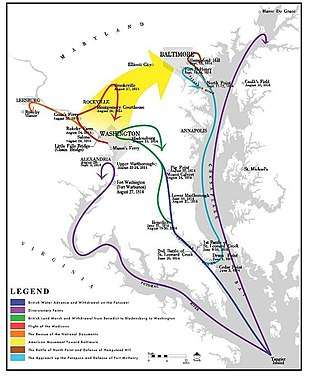
Background
British plans
For the first two years of the War of 1812 (1812–1815), the British had been preoccupied with the war against Napoleon and his French Empire (France) in Europe. However, warships of the Royal Navy, led by Admiral Sir Alexander Cochrane, commander of the North American Station (coast) and Rear Admiral George Cockburn, controlled Chesapeake Bay from early 1813 onwards and had captured large numbers of U.S. trading vessels. They occupied Tangier Island off the coast of Virginia, establishing Fort Albion as an anchorage and staging area. As many as 1,200 British soldiers would be stationed there. Raiding parties had destroyed foundries, batteries and several small towns, but lack of troops restricted Cockburn to mounting small-scale raids, the largest of which was the Battle of Craney Island, in the Hampton Roads harbor near Norfolk, Virginia, which involved 2,000 men of the British Army and the Royal Marines. Although Cockburn withdrew from Chesapeake Bay late in 1813, his sailors had taken soundings and even placed buoys to mark channels and sandbars, in preparation for a renewed campaign in 1814.[8]
By April 1814, Napoleon had been defeated and was exiled to the island of Elba off the coast of Italy. Large numbers of British ships and troops were now free to be used to prosecute the former backwater war with the United States. Most of these troops went to Canada where Lieutenant General Sir George Prevost, Governor General of Canada and commander in chief in North America, was preparing to lead an invasion into New York from Canada, heading for Lake Champlain and the upper Hudson River. However, the Earl of Bathurst, Secretary of State for War and the Colonies, dispatched a brigade composed mainly of veterans from the Duke of Wellington's army and commanded by Major General Robert Ross, to Bermuda, from where a blockade of the U.S. coast and even the occupation of some coastal islands had been overseen throughout the war. The intention was for this force to carry out raids on the Atlantic Seaboard to "effect a diversion on the coasts of the United States of America in favor [sic] of the army employed in the defence of Upper and Lower Canada".[9]
United States plans and preparations
Meanwhile, Albert Gallatin, President James Madison's nominated commissioner for negotiations with the British government, sent news from Europe of Napoleon's abdication and the apparent hardening of British attitudes towards the United States.[10] On 1 July 1814 Madison summoned his cabinet to discuss the increased threat to the United States' Atlantic coast, including Washington, although the Secretary of War, John Armstrong, insisted that the British would not attack Washington, since it was strategically unimportant. He felt the most likely target would be the city of Baltimore,[11] which offered more commercial targets and plunder than Washington. Armstrong was half right; the British would launch attacks against both Baltimore and Washington.
Nevertheless, on 2 July, Madison designated the area around Washington and Baltimore as the United States Army's Tenth Military District and, without consulting Armstrong, appointed Brigadier General William H. Winder as its commander.[12] Winder was the nephew of Levin Winder, Federalist Governor of Maryland. He had practiced law in Baltimore before being commissioned as a colonel in 1812 and had only recently been exchanged after having been captured at the Battle of Stoney Creek in July 1813. On 5 July, he and Armstrong conferred. Winder suggested calling up some militia in advance of any attack, but Armstrong insisted that militia could best be used on the spur of the moment.[13] Winder spent a month visiting the forts and settlements in his new command. Armstrong did not provide him with any staff, and despite his fears that the British could launch an attack against almost any point with very little warning, Winder did not order any field fortifications to be constructed, nor make any other preparations.[14]
Campaign
British moves
Although Major General Ross commanded the British troops in Chesapeake Bay, the point of attack was to be decided by Vice Admiral Alexander Cochrane, commander in chief of the Royal Navy's North American Station. Cochrane had concentrated four ships of the line, twenty frigates and sloops of war and twenty transports carrying Ross's troops at Tangier Island.[15] Rear Admiral Cockburn, Cochrane's second in command, favoured a quick attack on Washington, but Ross was not eager. His men had been confined aboard their transports for nearly three months, and he lacked cavalry, artillery and transport. Ross was also wary of the U.S. Chesapeake Bay Flotilla, lurking in the Patuxent River.[16] His first objective had to be the capture or destruction of the U.S. flotilla.
Cochrane dispatched two forces to make diversions. The frigate HMS Menelaus and some small craft threatened a raid on Baltimore, while two frigates and some bomb ketches and a rocket vessel ascended the Potomac River, an expedition that resulted in the successful Raid on Alexandria. His main body proceeded into the Patuxent. Ross's troops landed at Benedict on 19 August, and began marching upstream the following day, while Cockburn proceeded up the river with ships' boats and small craft. By 21 August, Ross had reached Nottingham, and Commodore Joshua Barney was forced to destroy the gunboats and other sailing craft of the Chesapeake Bay Flotilla the next day, and retreat overland towards Washington.
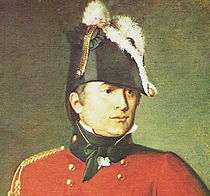

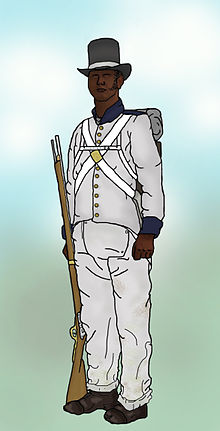
From Nottingham, Ross continued up the Patuxent to Upper Marlboro, from where he could threaten to advance on either Washington or Baltimore, confusing the Americans. He might have taken the capital almost unopposed had he advanced on 23 August, but instead he rested his men and organised his force. On the night of 23–24 August, at the urging of Rear Admiral Cockburn and some of the British Army officers under his own command, Ross decided to risk an attack on Washington. He had four infantry battalions, a battalion of Royal Marines, a force of about 200 men of the Corps of Colonial Marines, which was composed of locally recruited black refugees from slavery, a rocket detachment from the Royal Marines battalion, 50 Royal Sappers and Miners, 100 gunners from the Navy and 275 sailors to carry supplies. His force totaled 4,370 men, with one 6-pounder gun, two 3-pounder guns[17] and sixty launchers,[2] each being attached to a Congreve rocket.[Note 2] Rear Admiral Cockburn accompanied his force.
Ross had a choice of two routes by which he could advance: from the south via Woodyard or from the east via Bladensburg. The former route would involve finding a way across an unfordable part of the Eastern Branch of the Potomac (now called the Anacostia River) if the U.S. destroyed the bridge on the route. In the morning of 24 August, Ross made a feint on the southern route, before suddenly swerving northwards towards Bladensburg.
U.S. moves
In Washington, Brigadier General Winder could call in theory upon 15,000 militia, but he actually had only 120 dragoons and 300 other Regulars, plus 1,500 poorly trained and under-equipped militiamen at his immediate disposal.[18] On 20 August, Winder ordered this force to advance south towards Long Old Fields and Woodyard (off modern Route 5) to confront the British forces at Upper Marlboro. After a brief clash with Ross's leading units on 22 August, Winder ordered a hasty retreat to the Long Old Fields.[2] He feared that the British might make a surprise night attack, in which the British would hold the advantage in organisation and discipline while Winder's own advantage in artillery would count for little.[19] Winder had been captured in just such a night attack at Stoney Creek the year before.
Although he rode with the forces directly challenging the British invaders, Winder realized that Bladensburg was the key to Washington's defence. Bladensburg commanded the roads to Baltimore and Annapolis, along which reinforcements were moving to join him. The town also lay on one of the only two routes available for the British to advance on Washington, in fact the preferred route because the Eastern Branch was easy to ford there. On 20 August, Winder had ordered Brigadier General Tobias Stansbury to move from Baltimore to Bladensburg,[20] "take the best position in advance of Bladensburg ... and should he be attacked, to resist as long as possible".[21]
On 22 August, Stansbury deployed his force on Lowndes Hill, where he hastily dug earthworks for artillery emplacements. The road from Annapolis crossed the hill, and the road from Upper Marlboro ran to its south and west. Furthermore, the roads to Washington, Georgetown, and Baltimore all intersected behind between it and Bladensburg. From this position, Stansbury dominated the approaches available to the British while controlling the lines of communication.
At 2:30 a.m. on 23 August, Stansbury received a message from Winder, informing him that he had withdrawn across the Eastern Branch and he intended to fire the lower bridge. Surprised, Stansbury was seized by an irrational fear that his right flank could be turned. Instead of strengthening his commanding position, he immediately decamped and marched his exhausted troops across Bladensburg bridge, which he did not burn, to a brickyard 1.5 miles (2.4 km) further on. He had thus thrown away almost every tactical advantage available to him.
Meanwhile, in Washington, every government department was hastily packing its records and evacuating them to Maryland or Virginia, in requisitioned or hired carts or river boats.[22]
Battle
U.S. dispositions
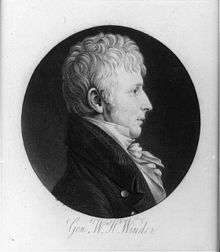
Winder now had at least 1,000 regulars from the U.S. Army, U.S. Navy, and U.S. Marine Corps, plus about 7,000 less than dependable militia and volunteers from the District of Columbia, Maryland and Virginia. Official reports of his strength range from 5,000 to 9,000 men. Winder's report to the Secretary of War stated that he was able "By the most active and harassing movement of the troops to interpose before the enemy at Bladensburg about 5,000."[23] Ross, the British commander, estimated the American force at between 8,000 and 9,000 men, with 300–400 cavalry. From other contemporary sources, the forces available for the defense of Washington probably numbered about 7,170, of which 6,370 were at Bladensburg.
Stansbury's force consisted of the 1st (Ragan's), 2nd (Schutz's), and 5th (Sterrett's) regiments of Maryland Militia, three companies of volunteer riflemen commanded by Major William Pinkney (a former United States Attorney General), and two companies of Baltimore artillery, with six 6-pounder guns. Ragan's and Schutz's regiments were hastily organised amalgamations of companies, all without uniforms. Sterrett's 5th Maryland Regiment was a "Dandy" regiment of uniformed volunteers.[20]
Stansbury chose a defensible position, though hardly the best one available, on the west side of the Eastern Branch of the Potomac opposite the town of Bladensburg. The artillery was posted in an earthwork hastily constructed by Colonel Decius Wadsworth, the Army's Commissary General of Ordnance, to the north of the bridge.[24] The earthwork had been designed for heavier weapons, and the 6-pounder field guns had a restricted field of fire through its embrasures. They could not use oblique fire to prevent the bridge from being seized. The Maryland militia infantry regiments were posted in a line of battle south of the earthwork, too far away to protect the artillery and exposed to British fire. Both Winder and Secretary of State James Monroe later tinkered with Stansbury's dispositions. Monroe moved companies and detachments without correcting the major faults in Stansbury's position, while Winder moved the three militia regiments into even more exposed positions behind the Baltimore artillery's redoubt, though Monroe reinforced them with a militia artillery company under Captain Benjamin Burch.[25] Monroe also ordered the 120 U.S. Dragoons under Colonel Jacint Lavall to occupy a ravine behind Stansbury's infantry, but left them without further orders or information.[26]
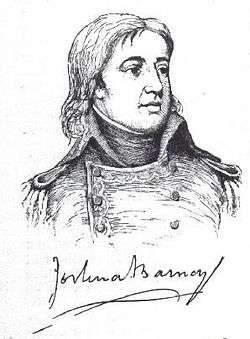
Behind Stansbury's troops and to his right was a brigade of District of Columbia militia under Brigadier General Walter Smith, which had marched from Long Old Fields. Smith's brigade was strongly posted behind a creek and along the crest of some rising ground, but Smith had not conferred with Stansbury before deploying his brigade, and there was a gap of a mile between them. Smith's men would be unable to support Stansbury, and if Stansbury were overcome, Smith's left flank would be open to attack. A battalion under Lieutenant Colonel Kramer lined the creek. Joshua Barney's men, with two 18-pounder guns and three 12-pounder guns drawn from the Washington Navy Yard, were posted astride the Washington turnpike. (Barney had originally been posted to guard the lower bridge over the Eastern Branch and destroy it if necessary, but he had pleaded to President Madison and the Secretary of the Navy that he and his men were needed where the action was.)[27] To Barney's left was the 1st Regiment of "District" Militia, a militia artillery company under Major George Peter with six 6-pounder guns and a provisional battalion of regulars under Lieutenant Colonel William Scott. The 2nd District Militia were posted behind Peter and Scott.[28]
To Smith's right rear in turn was a column of Maryland militia under Colonel William Beall, which had just arrived from Annapolis. A regiment of Virginia Militia under Colonel George Minor was delayed by administrative confusion and arrived on the field only as the battle ended.[29] (Minor's men had arrived in Washington without arms or ammunition. When Minor prevailed on Winder to order muskets to be distributed on the morning of the battle, the junior officer responsible for issuing their flints insisted that they be returned and recounted.)[30]
Stansbury's troops were tired from two days' constant alarms and redeployments, and Smith's and Beall's men were equally exhausted from having force-marched to the battlefield through a hot and humid summer day, with many diversions and unnecessary panics.
Action
Around noon on 24 August, Ross's army reached Bladensburg. Stansbury's tactical errors quickly became apparent. Had he held Lowndes Hill, Stansbury could have made the British approach a costly one (although this would have involved fighting with the East Branch at his back, which would not have improved his men's morale and might have been disastrous in a hasty retreat).[24] Had he held the brick structures of Bladensburg, which were ready-made mini-fortresses, he might have embroiled Ross's troops in bloody street fighting. Because the bridge had not been burned, it had to be defended. Stansbury's infantry and artillery were posted too far from the river's edge to contest a crossing effectively.
The British advance was led by Colonel William Thornton's 85th Light Infantry and the three light companies of the other line battalions. The Baltimore artillery and Pinkney's riflemen stopped Thornton's first rush across the bridge. Major Harry Smith, Ross's Brigade major, considered that Ross and Thornton had attacked too hastily, without waiting for other units to support Thornton, or sending forward skirmishers across the fords to cover the advance.[31] However, Thornton's men eventually established themselves on the south bank of the river, and began advancing in loose order. The Baltimore artillery had solid shot only, which was of little use against scattered skirmishers.[32] Pinkney (whose elbow was shattered by a musket ball)[33] was driven back and as Thornton's men closed in, the Baltimore artillerymen retreated with five of their cannon, being forced to spike and abandon another.
The British 1/44th Regiment had meanwhile forded the East Branch above the bridge. As they prepared to envelop the American left, Winder led a counter-attack against Thornton by Sterrett's 5th Maryland militia, joined by other detachments.[34] As the 5th Maryland exchanged fire with British infantry in cover on three sides, Schutz's and Ragan's conscripted militia broke and fled under a barrage of Congreve rockets. Winder issued confused orders for three of Captain Burch's guns to fall back rather than cover Sterrett's retreat, and the 5th Maryland and the rest of Stansbury's brigade fled the field, sweeping most of Lavall's horsemen with them.[35]
The British pressed on and were engaged by Smith's brigade and Barney's and Peters's guns. Thornton's light brigade made several frontal attacks over the creek, but were repulsed three times by artillery fire, and were counter-attacked by Barney's detachment.[36] Thornton was badly wounded and his light infantry were driven back with heavy casualties. However, as the 1/44th threatened Smith's open left flank, Winder ordered Smith to retreat also.[37]
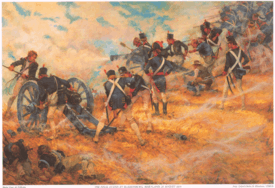
Smith's brigade fell back initially in good order, but Winder's orders to retreat apparently did not reach Barney, and his situation worsened when the civilian drivers of the carts carrying his reserve ammunition joined the general rout,[38] leaving the Marine gun crews with fewer than three rounds of canister, round shot and charges in their caissons. Barney's 300 sailors and 103 Marines nevertheless held off the British frontal attacks. Eventually, as the British 1/4th and 1/44th Regiments enveloped their left flank, Barney ordered his men to retreat to avoid capture.[39] Barney himself was badly wounded in the thigh with a musket ball and was taken prisoner. Beall's troops were also driven from the hill they held, after an ineffectual resistance.[36]
Winder had not given any instructions before the battle in the case of a retreat and as the American militia left the battlefield, he issued contradictory orders to halt and reform, or fall back on the Capitol where Secretary of War John Armstrong, Jr. hoped vainly to make a stand, using the federal buildings as strongpoints, or retreat through Georgetown to Tenleytown. Most of the militia simply fled the field with no destination in mind, or deserted the ranks to see to the safety of their families.[40]
Casualties
Although the British had suffered heavier casualties than the Americans (many inflicted by Barney's guns), they had completely routed the defenders. British casualties were 64 dead and 185 wounded.[3] Some of the British dead "died without sustaining a scratch. They collapsed from heat exhaustion and the strain of punishing forced marches over the five days since landing at Benedict".[41] Heidler's Encyclopedia of the War of 1812 gives the American loss as "10 or 12 killed, 40 wounded" and "about 100" captured.[3] Henry Adams and John S. Williams both give the American casualties as 26 killed and 51 wounded.[42] Joseph A. Whitehorne says the Americans lost "120 taken prisoner, many of these wounded".[43] Ten cannon and two colors-1st Harford Light Dragoons {Maryland} and the James City Light Infantry {VA}[44] were captured by the British.[6] For many of the American wounded, Naval Hospital Washington was the primary treatment center. Thirty-three incoming patients recorded in August and September 1814 were American seamen, soldiers, and marines wounded from Bladensburg or subsequent engagements. One British soldier, Jeremiah McCarthy is also recorded. The majority of those wounded however, were first treated on the field of battle and often by British surgeons. Despite the war, both sides generally respected hospitals and afforded care to the enemy wounded. The naval hospital's 1814 register reflects American seamen Frederick Ernest and George Gallagher both endured amputations in the field.[45]
Aftermath
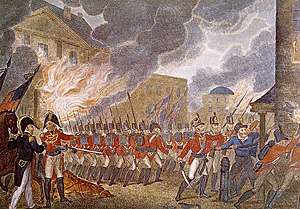
The hasty and disorganized American retreat led to the battle becoming known as the "Bladensburg Races" from an 1816 poem. The battle was termed "the greatest disgrace ever dealt to American arms" and "the most humiliating episode in American history".[37] The American militia actually fled through the streets of Washington. President James Madison and most of the rest of the federal government had been present at the battle, and had nearly been captured. They too fled the capital, and scattered through Maryland and Virginia. That same night the British entered Washington unopposed and set fire to many of the government buildings in what became known as the Burning of Washington.
Lieutenant General Prevost had urged Vice Admiral Cochrane to avenge the Raid on Port Dover on the north shore of Lake Erie earlier in the year, in which the undefended settlement had been set ablaze by American troops. Cochrane issued a proclamation that American property was forfeit; only the lives of the civilian inhabitants were to be spared. He had issued a private memorandum to his captains however, which allowed them to levy what was effectively protection money in return for sparing buildings. In fact, there was little or no looting or wanton destruction of private property by Ross's troops or Cochrane's sailors during the advance and the occupation of Washington. However, when the British later withdrew to their ships in the Patuxent, discipline was less effective (partly because of fatigue) and there was considerable looting by foraging parties and by stragglers and deserters.[46]
After Major General Ross was killed at the Battle of North Point on 12 September 1814, his descendants were given an augmentation of honour to their armorial bearings by a royal warrant dated 25 August 1815, and their family name was changed to the victory title Ross-of-Bladensburg in memory of Ross's most famous battle.[47]
The lineages of the 5th Maryland Regiment and the Columbian Division are perpetuated by the present-day 175th Infantry (ARNG MD) and the HHD/372nd Military Police Battalion (ARNG DC), two of only nineteen Army National Guard units with campaign credit for the War of 1812. The lineages of the old 36th and 38th Infantry Regiments are perpetuated by three currently active battalions of the 4th Infantry (1-4 Inf, 2-4 Inf and 3-4 Inf).
In the British Army, the Battle Honour "Bladensburg" was awarded to the 4th, 21st, 44th and 85th Regiments of Foot. The successor units within the British Army are, respectively: The Duke of Lancaster's Regiment, the Royal Regiment of Scotland, the Royal Anglian Regiment and the Rifles.
Black fighters
Blacks fought on the American force at Bladensburg, many as members of Commodore Joshua Barney's naval flotilla.[48] This force provided crucial artillery support during the battle.[49] One of the best accounts is that of Charles Ball, born 1785. Ball served with Commodore Barney at Bladensburg and later helped man the defenses at Baltimore. In his 1837 memoir, Ball reflected on the Battle of Bladensburg: "I stood at my gun, until the Commodore was shot down... if the militia regiments, that lay upon our right and left, could have been brought to charge the British, in close fight, as they crossed the bridge, we should have killed or taken the whole of them in a short time; but the militia ran like sheep chased by dogs."[50] Modern scholars estimate that blacks made up 15% to 20% of the American naval forces in the War of 1812.

Just before the battle, Commodore Barney, on being asked by Madison "if his negroes would not run on the approach of the British?" replied: "No Sir... they don't know how to run; they will die by their guns first."[51] The Commodore was correct as the men did not run; one such man was young sailor Harry Jones (No. 35), apparently a free black. Jones was wounded in the final action at Bladensburg and remained a patient at the Naval Hospital Washington, DC, for nearly two months.[52]
Blacks also fought on the British side with the Colonial Marines in the attacks on Bladensburg and Washington DC. Vice Admiral Sir Alexander Cochrane formed the Corps of Colonial Marines in 1813, deliberately recruiting enslaved blacks with a promise of freedom for themselves and their families. The corps received the same training, uniforms, pay, and pensions as their Royal Marine counterparts.[53] Following the Treaty of Ghent, the British kept their promise and in 1815 evacuated the Colonial Marines and their families to Halifax, Nova Scotia and Bermuda.[54]
Order of battle
British
- Regulars (total: 4500 all ranks) during the Chesapeake campaign.
(Major General Robert Ross)
- 1st (Light) Brigade (Colonel William Thornton) (1100 men)[17]
- 85th Regiment of Foot (Bucks Volunteers)(Light Infantry)
- Light companies, 1/4th, 21st, 1/44th Foot
- Company of Royal Marines, commanded by Lt Athelstan Stevens, detached from the Royal Marine battalion
- Rocket Detachment of 26 Royal Marine Artillery gunners, commanded by Lt John Lawrence, likewise detached from the Royal Marine battalion
- Company of Colonial Marines overseen by Captain Reed of the 2nd West India Regiment
- 2nd Brigade (Colonel Arthur Brooke) (1460 men) – in the rear[17]
- 1st Battalion, 4th (King's Own) Regiment of Foot, minus the Light infantry company
- 1st Battalion, 44th (East Essex) Regiment of Foot, minus the Light infantry company
- 3rd Brigade (Colonel Patterson) (ca. 1460 men) – in the rear[17]
- 21st Regiment (Royal North British Fusiliers), minus the Light infantry company
- 2nd Battalion, Royal Marines (commanded by Major James Malcolm) less one infantry company with the 1st Brigade, and the Rocket Detachment with the 1st Brigade.
- composite battalion (formed from ship-based Marines) commanded by Captain John Robyns and guarding the shoreline at Benedict
Note: there were a total of 1350 Marines throughout the Chesapeake campaign[55]
American
- Regulars (total: 960 to 1160 all ranks).
- 1 Squadron, Regiment of Light Dragoons,[56] commanded by Colonel Jacint Laval, 140 horses.
- 1 Infantry Battalion, United States Regulars commanded by Lieutenant Colonel William Scott – variously reported at either 300 or 500 men all ranks.
- Detachment of 103 United States Marines and 300 US Navy Flotilla men (sailors), under command of Commodore Joshua Barney, 400 (approx) all ranks with 5 heavy artillery pieces (two 18-pounders (naval) and three wheeled 12-pounders (USMC).
- Militia (total: 6,203)
- District of Columbia 1st Regiment of Militia, Colonel George Magruder, 535 all ranks
- District of Columbia 2nd Regiment of Militia, Colonel Wm. Brent, 535 all ranks
- Company of District of Columbia Union Rifles, Captain John Davidson, 116 all ranks
- Company of District of Columbia Rifles, Captain John Stull, 116 all ranks
- Detachment of Navy Yard Rifles (volunteers), Captain John Doughty, 116 all ranks
- Detachment of Captain Maynard, 100 men all ranks
- Detachment of Captain Waring, 100 men all ranks
- District of Columbia Dragoons, 50 horse
- Battery, The Washington Irish Artillery, Captain Ben Burch, ? x 6-pounders, 150 all ranks
- Battery, The District of Columbia Militia Artillery (Georgetown Artillery), Major George Peter, ? x 6-pounders, 150 all ranks.
- 1st Regiment, Baltimore County Militia, Colonel Jonathan Shutz, 675 all ranks
- 2nd Regiment, Baltimore County Militia, Colonel John Ragan, 675 all ranks
- 5th Baltimore City Regiment, Colonel Joseph Sterrett, 500 all ranks
- 1 Battalion, Baltimore Rifles, Major William Pinkney, 150 all ranks
- 2 Batteries, Baltimore Militia Artillery, ? x 6-pounders, 150 all ranks
- Annapolis Militia, Colonel Hood, 800 all ranks
- Battalion, Maryland State Militia, 250 all ranks
- Harford County Light Dragoons 240 horse
- Virginia Militia Dragoons, 100 horse (amalgamated with Laval's Dragoons during the battle)
- 60th Virginia Militia Regiment, Colonel George Minor, 700 all ranks (Arrived late and without ammunition and held in reserve)
- The James City Light Infantry, 100 all ranks. (their colors were captured by the British)
- Total Regular and Militia: 7,163 to 7,363
- 2 x 18-pounder guns
- 3 x 12-pounder guns
- 23 x 6-pounder guns
Battlefield preservation
Like many historic battlefields that once belonged to the rural American landscape, urban sprawl and heavily-traveled roads associated with urbanization in the DC metro area have made it very difficult to preserve and acquire the complete site of the Bladensburg battleground. However, the City of Bladensburg, in association with Prince George's County and the State of Maryland, has set up a number of historical markers in various places of importance on the battlefield and offers a walking tour, with a free audio "tour guide" to help one explore the battlefield itself. Prince George's County had also established a museum for the battle at the City of Bladensburg's waterfront park, but the museum is permanently closed.
Honors
References
- Footnotes
- The rocket itself would be attached to the side of a stick, doing so allowed them to be launched at a greater range. The "launcher" is the stick, which, when coupled with the rocket, would be mounted upon a bombarding frame, and fired.Rockets inspired Francis Scott Key
- The rocket itself would be attached to the side of a stick, doing so allowed them to be launched at a greater range. The "launcher" is the stick, which, when coupled with the rocket, would be mounted upon a bombarding frame, and fired.
- Citations
- Crawford (2002), p221, quoting a letter from Rear Admiral Cockburn to Vice Admiral Cochrane dated 27 August 1814 'a victory gained.. by a Division of the British Army not amounting to more than Fifteen hundred Men....The Seamen with the guns were ...with the rear... those however attached to the Rocket Brigade were in the Battle'
- Elting, p.207
- Heidler & Heidler, p.56
- Gleig, pp.124-5 'The loss on the part of the English was severe, since, out of two thirds of the engaged [being unscaved, however], upwards of five hundred men were killed and wounded.' Gleig is mistaken in 1827 in thinking that a third of the men were casualties, the figure was closer to one sixth.
- Gleig, George (1840). "Recollections of the Expedition to the Chesapeake, and against New Orleans, by an Old Sub". United Service Journal (1).
From the circumstance of the American artillery... completely enfilading the bridge.. our loss was much more severe than it would otherwise have been...Grand total, 249 hors de combat.
- Quimby, p.689
- Howe (2007), p.63
- Howard (2012), p.97
- Hitsman, p.240. Instructions from the Earl of Bathurst to Ross.
- Howard (2012), pp.116-117
- Howard (2012) p.129
- Snow (2013), p.25
- Howard (2012), p.135
- Howard (2012), pp.136-138
- Forester, p.180
- Elting, p.204
- Gleig, George Robert (1827). The Campaigns of the British Army at Washington and New Orleans, 1814-1815. pp. 94–95.
- Hitsman, p.241
- Howard (2012), p.168
- Elting, p.206
- "Narrative of General Winder, addressed to the chairman of the Committee of Investigation" as quoted in Williams, John S. (1857). "Appendix I". History of the Invasion and Capture of Washington, and of the Events Which Preceded and Followed. New York: Harper & Brothers. pp. 316–317. Retrieved 22 February 2011.
- Howard (2012), pp.166-167
- Eaton, p.9
- Elting, p.213
- Elting, p.214
- Snow (2013), p.86
- Howard (2012>, pp.178-179).
- Elting, p.215
- Elting, p.212
- Snow (2013), pp.72-73
- Snow (2013), pp.85-88
- Elting, p.216
- Snow (2013), p.90
- Elting, p.217
- Snow (2013), p.92
- Elting, p.218
- Howe, p.63
- Mostert, Noel (2007). The Line upon a Wind. Random House, London: Jonathan Cape. p. 667. ISBN 978-0-224-06922-9.
- Hitsman and Graves, p.243
- Elting, p.219
- Pitch, pp.80-81
- Quimby, p.689. Quimby refers to History of the United States of America during the Administration of Thomas Jefferson and James Madison (New York, The Antiquarian Press, 1962) by Henry Adams and History of the Invasion and Capture of Washington, etc. (New York, Harper and Brothers, 1857) by John S. Williams.
- Whitehorne, p.136
- "The 85th Light Infantry in North America 1812 - 1815". Shropshire Regimental Museum. Retrieved 17 September 2013.
- Register of Patients at Naval Hospital Washington DC 1814 With the Names of American Wounded from the Battle of Bladensburg Transcribed with Introduction and Notes by John G. Sharp Harry Jones was patient number 35 and see note 8. https://www.history.navy.mil/research/library/online-reading-room/title-list-alphabetically/r/register-patients-naval-hospital-washington-dc-1814.html Accessed 22 May 2018
- Elting, p.222
- Lloyd, Ernest Marsh (1897). . In Lee, Sidney (ed.). Dictionary of National Biography. 49. London: Smith, Elder & Co.
- Charles E. Brodine, Michael J. Crawford and Christine F. Hughes, editors Ironsides! The Ship, the Men and the Wars of the USS Constitution (Fireship Press, 2007), 50
- Battle of Bladensburg Reputations Ruined University of Maryland https://www.lib.umd.edu/bladensburg/reputation-ruined/battle-of-bladensburg accessed 23 May 2018
- Charles Ball Slavery in the United States: A Narrative of the Life and Adventures of Charles Ball, a Black Man, Who Lived Forty Years in Maryland, South Carolina and Georgia, as a Slave Under Various Masters, and was One Year in the Navy with Commodore Barney, During the Late War (New York: John S. Taylor 1837).
- Elizabeth Dowling Taylor A Slave in the White House: Paul Jennings and the Madison's Palgrave (McMillen: New York 2012), p.49.
- Register of Patients at Naval Hospital Washington DC 1814 With the Names of American Wounded from the Battle of Bladensburg Transcribed with Introduction and Notes by John G. Sharp Harry Jones was patient number 35 and see note 8. https://www.history.navy.mil/research/library/online-reading-room/title-list-alphabetically/r/register-patients-naval-hospital-washington-dc-1814.html Accessed 22 May 2018
- William S. Dudley, editor The Naval War of 1812: A Documentary History Volume II. (Naval Historical Center: Washington, DC 1992), 324-325.
- Alan Taylor The Internal Enemy Slavery and War In Virginia. 1772 -1832, (WW Norton & Company: New York, 2013), 300-305, Appendix B.
- Crawford (2002), p290, quoting a letter from Vice Admiral Cochrane to Lord Melville dated 17 September 1814
- The United States Cavalry: an illustrated history, 1776 - 1944. Author Gregory J. W. Urwin, page 49.
- Eaton, pp. 9-14.
- Printed works
- Crawford, Michael J. (Ed) (2002). The Naval War of 1812: A Documentary History, Vol. 3. Washington: United States Department of Defense. ISBN 9780160512247
- Eaton, Captain Hamish Bain. Bladensburg. London: Journal of the Army for Historical Research, Vol 55, 1977, pp. 8–14. (FOR AMERICAN ORDER OF BATTLE ONLY)
- Elting, John R. (1995). Amateurs to Arms! A Military History of the War of 1812. New York: Da Capo Press. ISBN 0-306-80653-3.
- Forester, C.S. The Age of Fighting Sail. New English Library. ISBN 0-939218-06-2.
- George, Christopher T. (2001). Terror on the Chesapeake: The War of 1812 on the Bay. Shippensburg, Pa.: White Mane. ISBN 1-57249-276-7.
- Gleig, George Robert (1827), The Campaigns of the British Army at Washington and New Orleans, 1814-1815, London: J. Murray, ISBN 0-665-45385-X
- Heidler, David S.; Heidler, Jeanne T. (1997). Encyclopedia of the War of 1812. Annapolis, MD: Naval Institute Press. ISBN 1-59114-362-4.
- Hitsman, J. Mackay; Graves, Donald E. (1999). The Incredible War of 1812. Toronto: Robin Brass Studio. ISBN 1-896941-13-3.
- Howard, Hugh (2012). Mr. and Mrs. Madison's War. Bloomsbury. ISBN 978-1-60819-071-3.
- Howe, Daniel Walker (2007). What Hath God Wrought: the Transformation of America, 1815-1848. Oxford University Press US. p. 904. ISBN 978-0-19-507894-7.
- James, William (1818). A Full and Correct Account of the Military Occurrences of the Late War Between Great Britain and the United States of America volume 2. London. ISBN 0-665-35743-5.
- Latimer, Jon (2007). 1812: War with America. Cambridge, MA: Harvard University Press. ISBN 0-674-02584-9.
- Lord, Walter (1972). The Dawn's Early Light. W W Norton & Co Inc. ISBN 0-393-05452-7.
- Lossing, Benson J. (1896). Pictorial Field Book of the War of 1812. New York: Harper and Brothers.
- Paine, Ralph D. (1924). Joshua Barney. Century Co.
- Pitch, Anthony S. (2000). The Burning of Washington. Annapolis, MD: Naval Institute Press. ISBN 1-55750-425-3.
- Quimby, Robert S. (1997). The U.S. Army in the War of 1812: An Operational and Command Study. East Lansing: Michigan State University Press. ISBN 0-87013-441-8.
- Snow, Peter (2013). When Britain burned the White House. London: John Murray (Publishers). ISBN 978-1-84854-611-0.
- Swanson, Neil H. (1945). The Perilous Fight. Farrar and Rinehart.
- Whitehorne, Joseph A. (1997). The Battle for Baltimore 1814. Baltimore: Nautical & Aviation Publishing. ISBN 1-877853-23-2.
External links
| Wikimedia Commons has media related to Battle of Bladensburg. |
- Battle of Bladensburg: Reputation Ruined -University of Maryland Library
- University of Maryland Special Collections Guide on the War of 1812
- Battle of Bladensburg, War of 1812 Bicentennial preparations top Port Towns' priorities
- "The Short History of Defense of Maryland During the War of 1812," by John Miller
- War of 1812 British Regiments
- Animated history of the Battle of Bladensburg
- Battle of Bladensburg Map - Bladensburg Archaeology (video)
- "Beyond the Battle: Bladensburg Rediscovered" exhibit at the University of Maryland, College Park
- "Battle of Bladensburg bicentennial undaunted by rain", Hyattsville Community Newspaper, August 24, 2014